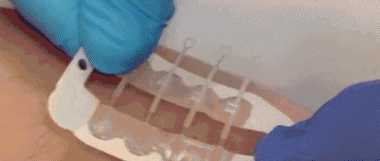When a wound occurs in the body, the body will automatically repair the wound, and the wound healing must be accompanied by the growth of scar tissue. Strictly speaking, scars are unavoidable, but there are some methods that can have a positive impact on the formation of scars, so that after the wound heals It's not so obvious, so what should we do, let's take a look with me below.
How do scars form?
The formation process of a scar can be divided into three stages: the inflammation stage, the proliferative stage, and the mature stage.
1. Inflammatory phase: It is a defense mechanism of the body, which confines, eliminates, and repels foreign pathogenic factors and dead cells through local tissue degeneration, exudation, and proliferation, thereby laying the foundation for wound healing.
2. Proliferative period: After the wound has healed, after 1-3 months, scars begin to proliferate on the edge of the wound, sometimes dilated capillaries can be seen, and the surface is rough, accompanied by itching, pain, and another discomfort.
3. Maturity period: Usually, the scar hyperplasia reaches its peak in about 6 months, and then the scar gradually matures and softens. The maturation process of scars is relatively slow, usually, it takes half a year to 2 years, and for some patients can take as long as 3-4 years, and the length of time for scars to mature in different parts is different.
Why does scarred new skin look different?
Over time, a wound grows new skin, and even if it doesn't have a prominent appearance, it still differs from healthy skin. Unlike healthy skin, where the elastic fibers crisscross, scar tissue has collagen fibers that are parallel. Hence the lack of flexibility. In addition, scars lack essential components of healthy skin, such as hair, sebaceous and sweat glands, and melanocytes, which are responsible for skin pigmentation. In addition, newly formed scar tissue cannot rehydrate itself or store enough water. This type of skin is very sensitive and scars should be treated properly.
Factors that affect scar type and aesthetics :
In addition to the type of wound injury, other factors can affect the type of scar and its visibility after healing, such as:
The size of the wound site: some wounds are on the more exposed parts of the body,
Wound Hygiene: Infection increases the risk of unsightly scarring.
The physical condition of the patient: Whether it is a scar constitution or not, consider the genetic cause.
The severity of injury: the extent of tissue loss and depth of the wound
Patient's age: As you get older, wounds don't usually heal as well as they did when you were younger.
To prevent scarring from becoming apparent, intervention should be done in the early stages of wound healing.
How to positively affect scar formation :
To reduce the impact scars can have on us, whether it is a burn, cut, laceration, scratch, or abrasion, the first step should be taken to treat the wound yourself immediately after the injury. Thoroughly clean and disinfect the wound with saline or tap water. Wound infections can slow the healing process and increase scar tissue formation. Do not scratch the scab that has formed, or germs can enter the wound and damage the skin again.
Some ways to positively affect scarring :
1. To avoid pulling or straining the wound, it is recommended to use Wound Skin Closure, which can prevent wound tension, avoid wound dehiscence, and protect granulation tissue from abnormal proliferation due to excessive collagen secretion, thereby inhibiting scar formation.
2. You can use silicone scar dressing, which has two types, one is Flakiness and Tubular. The main scar reduction mechanism of silicone scar stickers is that high-purity medical silicone components inhibit the proliferation of fibroblasts and capillaries, thereby preventing scars from Fading in color. Gel-type silicone is highly malleable and suitable for areas of skin irregularity or active children. When the gel is applied to the skin, it dries quickly and forms a breathable, transparent, and waterproof layer to protect against chemical, physical and microbial intrusion. Silicone scar gel has scar-improving properties due to the hydration of the scar and hydration provides better collagen tissue during the healing phase. It smoothes, softens, and smoothes scars, relieves itching, and reduces scar-related discoloration.
3. Avoid direct exposure of the wound to sunlight, please use sunscreen products to protect the scar.
In general, the appearance of scars can be positively affected throughout the regenerative phase, with about half a year to two years of use. During this period, the earlier regular treatment for scarring is started, the better.
For more information on Innomed® wound skin closure, refer to the previous articles. If you have customized needs, you are welcome to contact us; we will serve you wholeheartedly.
At Longterm Medical, we transform this data by innovating and developing products that make life easier for those who need loving care.
Editor: kiki Jia
Date: December 27, 2022

 English
English عربى
عربى Español
Español русский
русский 中文简体
中文简体








